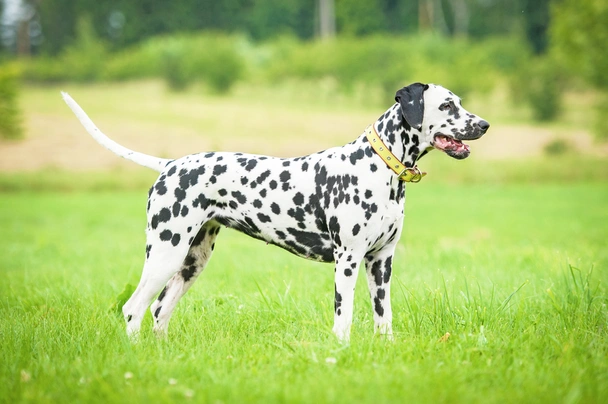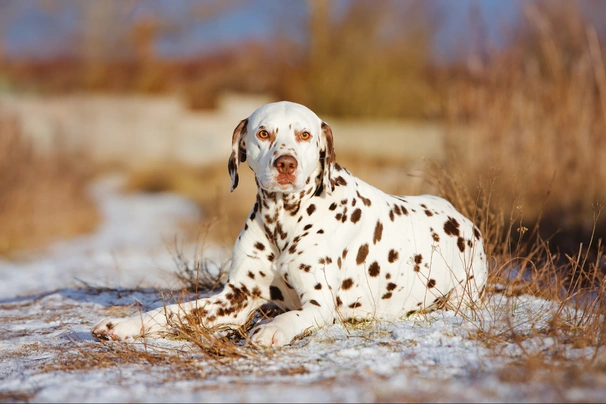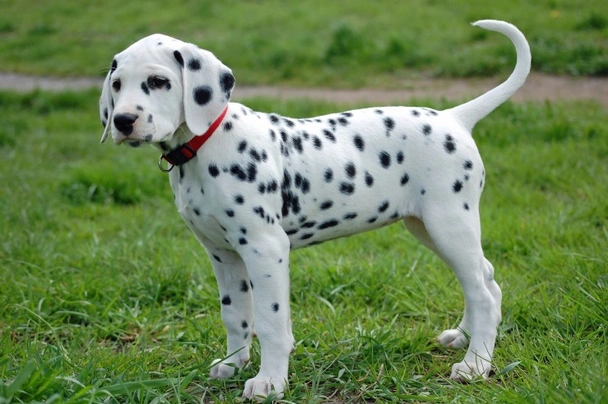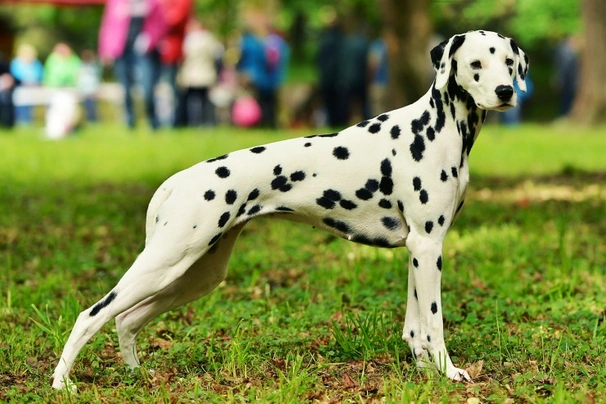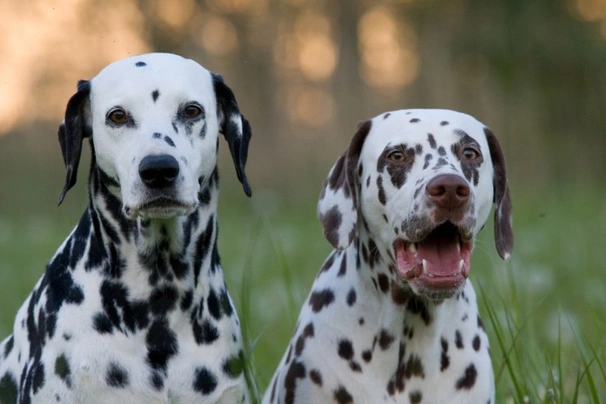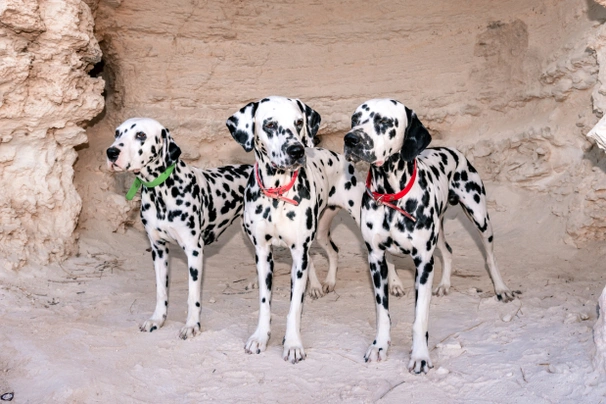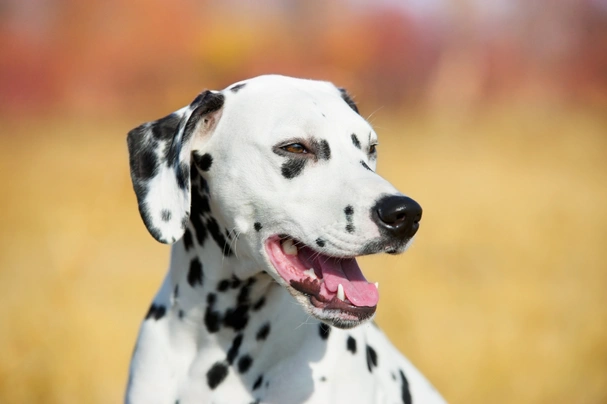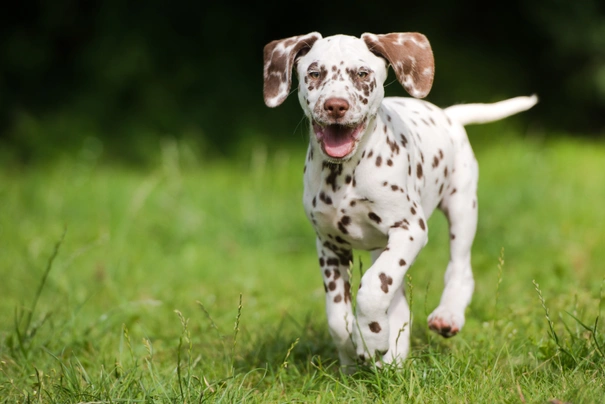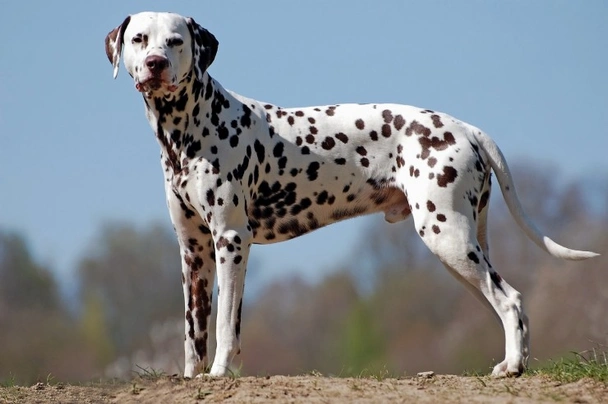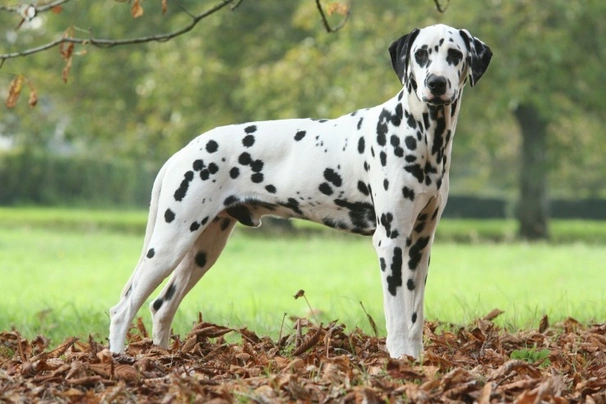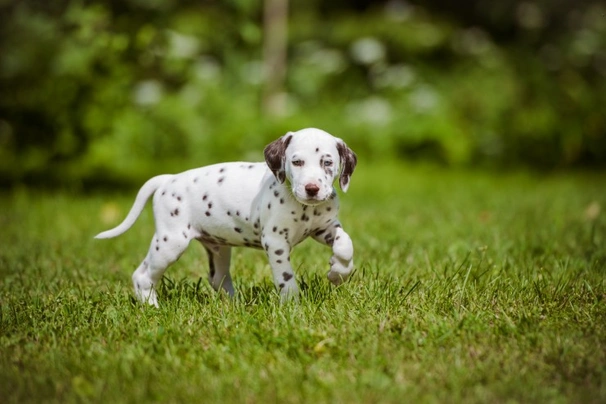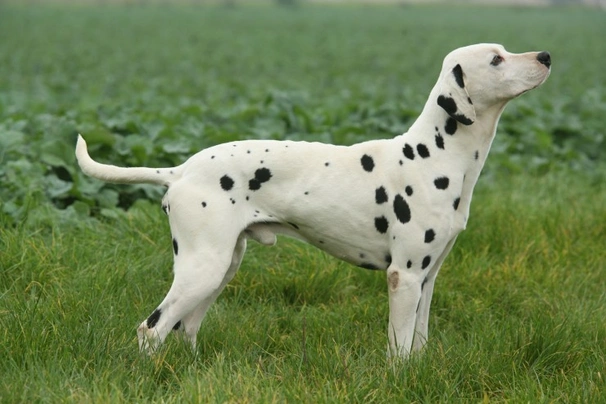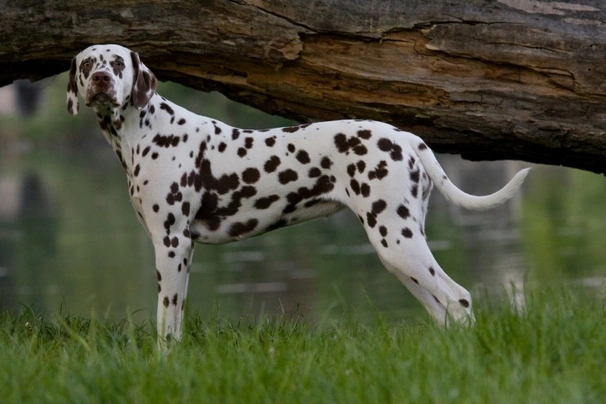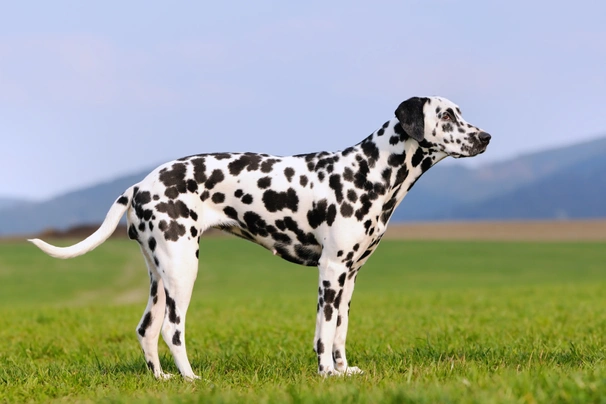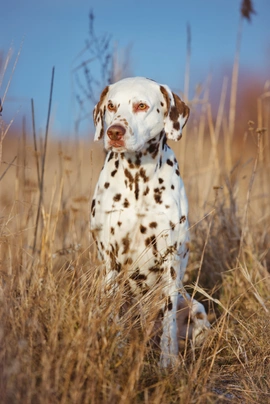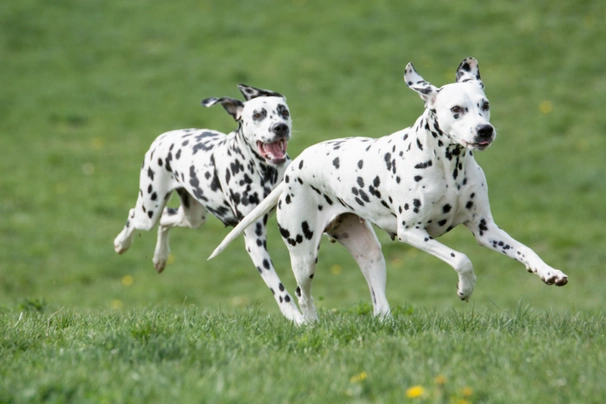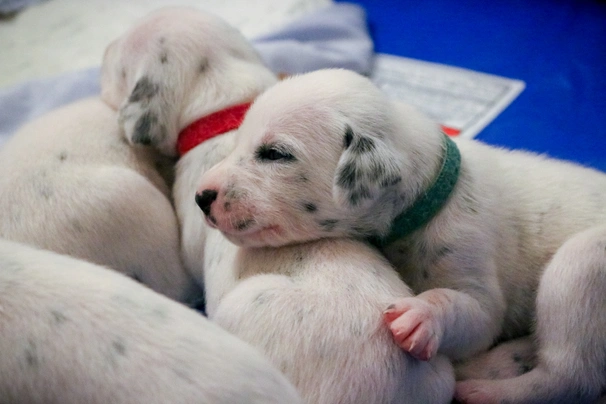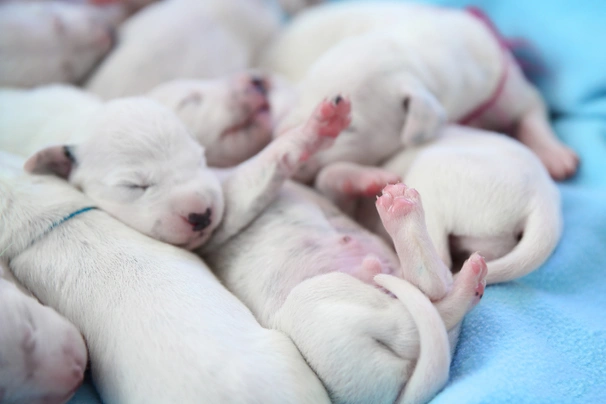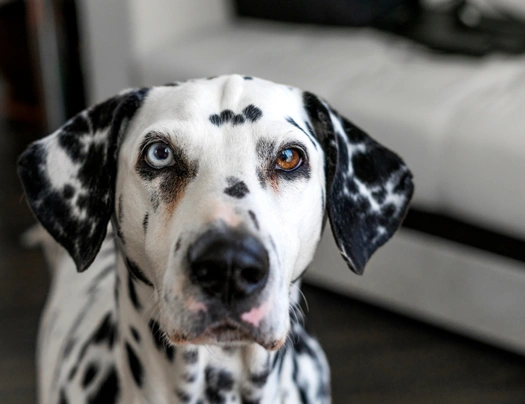Dalmatian
Pros
Cons
Introduction of the Dalmatian
Dalmatians are a unique breed not only in looks but in intelligence and character too. They are known the world over for their distinctive looks and beautifully spotted coats which is just one of the reasons they have remained extremely popular companions and family pets throughout the years. They were originally bred to run alongside carriages which included horse-drawn fire engines earning themselves the name of Firehouse Dogs.
Dalmatians have a tremendous amount of stamina they are active muscular strong dogs and they like nothing more than to be given lots of exercise and mental stimulation as such they excel at all sorts of canine sports. They have very loving personalities but they are also known to be natural watchdogs. Outgoing confident and extremely loyal a Dalmatian forms a strong tie with an owner and therefore hate being on their own for any length of time. A Dalmatian is the perfect choice for people who lead busy outdoor lives and who live in the country but they also do well living in town providing their owners have nice big secure gardens for them to roam around in as much as possible so dogs can really let off steam in a safe environment.
History of the Dalmatian
Dalmatians have a fascinating history with the first thing being about the breed being how they came about their name. It is thought that the name could derive from hounds that existed centuries ago called Dama-chien or from a coronation mantle that people wore called a dalmaticus but neither have ever been confirmed. What is known is that dogs with black spots in their coats were around as far back as the 18th Century.
With this said it is thought that Dalmatians are one of the most ancient breeds on the planet with evidence of them having been found on Greek friezes and tablets that date back 2000 BC in which dogs are depicted running alongside chariots in Ancient Egypt Rome and Greece. Records have also been found of these dogs in Dalmatia a region of Croatia which could be how the breed earned their name too.
It is thought that the breed found its way to other regions of Europe because they travelled with gypsies throughout the Mediterranean. However the dogs we see today were bred and developed by English nobility during the 19th Century and they were bred to run alongside carriages and thanks to their tremendous stamina and endurance they were also used for hunting too.
Over the years these striking dogs have been given many jobs and this includes being used to herd sheep hunt perform in the circus pull carts and as previously mentioned to run alongside coaches. They also became popular with fire departments with Dalmatians running ahead of the horse drawn fire trucks making sure the way ahead was clear.
Today Dalmatians remain a popular choice with people who live in the country and who own horses because of the breed's affinity with their equine counterparts. They are also often seen in Field Trials where they show off the natural abilities as working dogs but they are also a popular choice in other parts of the world thanks a Dalmatian’s kind nature and their wonderful spotted coats. Most English lines of the breed are bred with Scandinavian bloodlines which has improved the breed both in appearance and where health matters are concerned.
Interesting facts about the breed
- Is the Dalmatian a vulnerable breed? No they are one of the most popular dogs both in the UK and elsewhere in the world
- Many celebrities have owned and own Dalmatians including Ingrid Bergman and Paula Abdul
- They were once called Firehouse Dogs because they were popular with fire departments
- It is thought the breed may have been around in Ancient Egyptian times
- Dalmatian puppies are born without any spot in their coats
- No 2 Dalmatians have the same number of spots in their coats
- Studies have established that up to 12% of Dalmatians are born deaf
- The breed was made famous more recently by the film 101 Dalmatians
Appearance of the Dalmatian
Height at the withers: Males 58 - 61 cm Females 56 - 58 cm
Average weight: Males 23 - 25 kg Females 23 - 25 kg
The Dalmatian must be among one of the most recognised breeds on the planet not only because of their beautiful spotted coats but thanks to the movie 101 Dalmatians too. They are very proud elegant dogs that boast a tremendous amount of stamina as well as good turn of speed when needed.
They boast a longish flat head with a reasonable amount of width between their ears. They have a distinct stop and powerful muzzle with clean lips and a black nose although dogs with liver coats have brown noses. Their eyes are set nicely apart and are medium in size with dogs always showing an intelligent expression. Eyes are dark brown in black spotted Dalmatians but they are amber in colour in liver spotted dogs. Their rims are well pigmented with black spotted dogs having black pigmented rims and liver spotted Dalmatians having liver brown ones.
Their ears are moderately large and set high and wide on a dog’s head and they gently taper to a rounded point. Ears are fine to the touch and dogs carry them close to their heads. A Dalmatian’s ears are well spotted which adds to their charming appearance. Their jaws are strong with dogs boasting a perfect scissor bite where they upper teeth neatly overlap their lower ones.
Their necks are fairly long light and a dog’s shoulders are muscular and well laid back. Front legs are straight with dog’s having a good amount of bone from their elbows right down to their feet. Dalmatians have nicely proportioned bodies with deep chests and well sprung ribs. Their withers are well defined and they boast level powerful backs and strong muscular slightly arched loins. Hindquarters are well muscled with dog’s boasting a nicely developed second thigh and strong back legs.
Their feet are compact and round with toes that are well arched and very cat-like. Their nails can be either black or white when a dog’s coat is spotted black. However liver spotted dogs boast brown or white nails. Dalmatians have quite long spotted tails that are thicker at the base but taper to the tip which dogs carry with a slight curve.
When it comes to their coat the Dalmatian has a short dense sleek glossy hard coat. The accepted breed standard colours for registration are as follows:
- White with Black Spots
- White with Liver Spots
Dogs have well defined spots that are well distributed over their entire bodies which includes on their ears and tails.
Gait/movement
When a Dalmatian moves they do so smoothly with a powerful long stride covering a lot of ground with the greatest of ease. When seen from the front or back their legs look like they are straight with a dog's feet moving along a straight line which sees front legs tracking their back legs.
Faults
The Kennel Club frowns on any exaggerations or departures from the breed standard and would judge faults on how much they affect a dog's overall health and wellbeing as well as their ability to perform.
Male Dalmatians should have both testicles fully descended into their scrotums and it is worth noting that dogs can be a little taller or shorter as well as slightly heavier or lighter than set out in the breed standard which is given as a guideline only.
Temperament of the Dalmatian
Dalmatians mature slowly and don't really reach full maturity until they are anything from 12 to 15 months old. Males tend to be that much heavier taller and therefore stronger than their female counterparts. Females are known to be a bit moody at times whereas males tend to be more stable. With this said male Dalmatian can show a more dominant side to their natures more especially when they meet other male dogs whereas females tend to get on with everyone and everything although they do make natural watchdogs and will protect their families and property without being aggressive in the way they go about it.
In general Dalmatians are friendly confident and outgoing. Rarely would a dog show any sort of aggressive behaviour more especially if they are well-bred and have been nicely socialised right from the word go. The Dalmatian is a good choice for first time owners providing they are prepared to give an active highly intelligent canine companion the correct amount of physical exercise and mental stimulation to keep them happy.
Although originally bred as working dogs whether in a hunting environment or as a carriage dog over the years the Dalmatian has become a firm favourite both in the show ring as a family pet and companion. They are active dogs and like nothing more than to be kept busy but there is a bit of a downside to this because Dalmatians form very strong bonds with their owners which can lead to them developing separation anxiety when left on their own. As such they are not a good choice for people who spend most of the day out of the house leaving their pets alone. Ideally these dogs need to be in a family where at least one of the household stays at home during the day when everyone else is out of the house. Another alternative is to have another dog and preferably another Dalmatian so they keep each other company.
It's important for these dogs to be well socialised from a young age and to be introduced to as many new situations people and other animals as possible for them to grow up to be well-rounded confident adult dogs. They also benefit from being enrolled into obedience classes when young which helps these dogs understand their place in the pack and who is alpha dog in a household. They can be a little wary around strangers but once they get to know someone they generally get a lot friendlier towards them.
Dalmatians are highly intelligent and pick things up quickly with the downside being they pick up bad habits just as fast so it's essential for the education to start early and for it to be consistent and fair throughout a dog's life so they understand what an owner expects of them and the ground rules that have been set.
Are they a good choice for first time owners?
Dalmatians are a good choice for first time dog owners because they are so amenable to learning new things and love nothing more than to please. However they are not suited to households where everyone is out which means they are left on their own for any length of time. The reason being is that Dalmatians are extremely people-oriented and hate it when they are left on their own.
What about prey drive?
Although originally bred to hunt the modern Dalmatian does not have a very high prey drive although some dogs just cannot resist chasing a rabbit or a neighbour's cat when the chance arises. A well-bred and nicely trained Dalmatian however can be trusted to walk off the lead and still stay well-behaved around other animals providing they respond well to the recall command.
What about playfulness?
Dalmatians have a real sense of humour and love nothing more than to entertain and be entertained. As previously mentioned they mature slowly and remain very playful well into the senior years. They enjoy playing interactive games and enjoy the company of slightly older children rather than toddlers more especially as playtime often gets a bit boisterous.
What about adaptability?
Dalmatians are better suited to people who have large secure back gardens a dog can roam around in whenever possible and would not be happy living in an apartment. They are energetic active and intelligent which means they must be kept busy both mentally and physically to be truly happy dogs.
What about separation anxiety?
As previously touched upon Dalmatians thrive on being around people and suffer from separation anxiety when they are not. They should never be left to their own devices for any longer than 2 to 3 hours otherwise they might start being destructive around the home which is their way of showing just how unhappy they are about things.
What about excessive barking?
Dalmatians are not known to be a breed that barks excessively. However an unhappy dog might start barking just to get attention which includes when they are left on their own for too long.
Do Dalmatians like water?
Some Dalmatians really enjoy swimming and will take to water whenever they can whereas others don't even like getting their feet wet and will even object to going out in the rain. Anyone sharing a home with a dog that loves swimming should always take extra care when walking their pets off the lead near more dangerous watercourses just in case they decide to leap in and need rescuing.
Are Dalmatians good watchdogs?
Dalmatians are natural watchdogs although they tend to love everyone more especially if they have been well bred. A badly bred Dalmatian may well end up being timid and shy around people but a well-bred dog would be outgoing and confident. With this said males tend to be a little more protective than their female counterparts but both will quickly let an owner know when they are strangers around or if something they don’t like is going on in their environment.
Intelligence / Trainability of the Dalmatian
Dalmatians being so intelligent are easy to train but they can be a little strong willed when the mood takes them. As such they need to be show patience and given enough time bearing in mind that Dalmatians only really mature when they are anything from 12 to 15 months old. The good news is that a Dalmatian would do anything for a high value treat making sure not to give a dog too many at any one time.
With this said if these dogs are not given the right sort of direction they are also quick to pick up bad habits which is why they need to be trained with a gentle yet firm hand. Another thing to bear in mind is that males tend to show a bit more of a dominant side to their character than their female counterparts. Dalmatians are often seen taking part in many canine sporting activities which includes Flyball agility and obedience to name but three and which they are known to excel at.
Puppies should be taught their first commands straight away and it's a good idea to enroll them into puppy classes once they have been given all their vaccinations which is a great way of socialising a young Dalmatian while at the same time training them in a safe and secure environment. The first commands a puppy should be taught are as follows:
- Come
- Sit
- Stay
- Quiet
- Leave it
- Down
- Bed
Children and other
Dalmatians are very kind dogs by nature and seem to have an affinity with children although it would be fair to say they are better suited to households where the kids are that much older rather toddlers. They are confident outgoing characters with puppies and younger dogs tending to be a little more boisterous than older dogs. It takes about two years for young Dalmatians to settle and become less energetic bearing in mind that they don't really mature until they are anything from 12 to 15 months old. With this said any interaction between the kids and a dog should be supervised by an adult to make sure things stay calm and nobody gets knocked over and hurt even by accident.
These dogs rarely show any sort of aggression towards other dogs pets or animals especially if they have been well socialised from a young age and they have grown up with them although male Dalmatians tend to want to dominate other male dogs. With this said care needs to be taken when a Dalmatian meets an unfamiliar cat because they will want to chase them although if they grow up with a cat in the home they generally get on well together.
Health of the Dalmatian
The average life expectancy of a Dalmatian is between 10 and 13 years when properly cared for and fed an appropriate good quality diet to suit their ages.
Like so many other breeds the Dalmatian is known to suffer from a few hereditary health issues which are worth knowing about if you are planning share your home with one of these active and good-looking dogs. The conditions that seem to affect the breed the most include the following:
- Deafness – Test available (BAER)
- Hip dysplasia – test available - the breed mean score is 10.5 and parent dogs should be lower
- Urinary stones - DNA test available
- Epilepsy
- Allergies - hives
- Acute respiratory distress syndrome (ARDS)
- Hypopigmentation
- Bloat
- Atopy - a hypersensitivity to pollens and other protein particles which causes intense itching
- Hepatitis – an autoimmune liver disease
- Shoulder osteochondrosis - abnormal bone and cartilage
- Panosteitis - young males can suffer from bone inflammation
- Various types of cancer
- Dilated cardiomyopathy
- Hypothyroidism
- Copper toxicosis
- Laryngeal paralysis
- Hypertonic myopathies
- Myelopathy
- Galactocerebrosidosis
- Ceroid lipofuscinosis
More about deafness
Dalmatians thanks to their white coats are predisposed to suffering from impaired hearing and deafness in either one or both of their ears. Fortunately dogs can be tested and the scheme has established that around 1 in 12 Dalmatians are totally deaf in both of their ears. Prospective owners should make sure that any puppies they are thinking of buying have hearing in one ear and that they are not deaf in both.
Dalmatian puppies can undergo a BAER test once they are 6 months old which would confirm if they are deaf or not and all responsible breeders would ensure their stud dogs are tested before being used for breeding purposes.
More about epilepsy
Seizures can be caused by many things which includes an underlying health issue. However epilepsy can be an inherited disorder too and although most episodes do not result in any sort of brain damage it can be extremely worrying when a dog has a fit for the first time. When the condition is inherited it is referred to as being idiopathic epilepsy. Most of the time the fits only last a short time and dogs although confused do come around and will start acting normally.
However they can happen in "clusters" and this can result in uncontrollable continuous seizures which are exhausting for a dog to have to experience and if not seen by a vet as a matter of urgency it can lead to brain damage and then death.
Dogs usually have their first seizure when they have inherited idiopathic epilepsy when they are anything from 1 to 5 years old. Females when they come into season may also experience more seizures because of the increased level of estrogen in their systems.
Once a dog has been examined and treated by a vet their condition can be managed and controlled with most Dalmatians going on to lead full and active lives.
More about urinary stones
There is a DNA test to see if dogs carry the gene that causes hyperuricosuria which are urate stones or (HUU). The condition sees uroliths forming in a dog's bladder which causes tremendous pain and inflammation. These stones can cause a blockage in their urinary tract. As time goes by the stones get larger as they cluster together and the reason why the crystals first form could be because of the following:
- Dogs have developed some form of urinary tract infection
- Diet can have a bearing on why dogs develop urinary stones more especially if the food contains a high amount of minerals
- Crystals can form because of a high level of acidity in a dog's urine
Some dogs don't show any signs of there being a problem until their bladder wall becomes inflamed and painful which leads to a constant need to urinate and when they do there is blood in their urine which are typical signs of cystitis. Should the crystals form in a dog's urethra it often causes a blockage in the tube and dogs have trouble urinating. If urine is retained it can negatively impact a dog's kidneys. Should a dog's bladder become distended and the wall bursts it can lead to them suffering from internal peritonitis.
What about vaccinations?
A Dalmatian puppy would have been given their initial vaccination before being sold however it is up to the new owner to make sure they have their follow-up shot on time. The vaccination schedule for puppies is as follows:
- 10 -12 weeks old bearing in mind that a puppy would not have full protection straight away but would be fully protected 2 weeks after they have had their second vaccination
There has been a lot of discussion about the need for dogs to have boosters. As such it's best to talk to a vet before making a final decision on whether a dog should continue to have annual vaccinations which are known as boosters.
What about spaying and neutering?
A lot of vets now prefer to wait until a dog is a little more mature before they are spayed or neutered. They therefore recommend waiting until dogs are 6 to 9 months old before they undergo the procedures. Other vets advise neutering and spaying a dog when they are 6 months old but never any younger unless there is a medical reason for doing so.
What about obesity problems?
Some Dalmatians put on weight after having been spayed or neutered and it's important to keep a close eye on their waistlines and to adjust their calorie intake and the amount of physical daily exercise they are given. Older dogs too are prone to put on weight and again it's important to adjust the amount of food they are fed every day to prevent them from gaining too many pounds. Obesity can seriously and negatively impact a dog's overall health and can even shorten their lives by several years.
What about allergies?
Dalmatians are prone to suffering from a condition known as "hives" which sees dogs developing bumps on specific areas of their bodies. The condition can be triggered by an allergic reaction or sensitivity to something. Urticaria or hives can be treated once the underlying trigger is established by a vet. Dogs suffering from the condition can in the meantime be made to feel more comfortable until the trigger is established. All too often in Dalmatians this can be due to a flea bite with the problem being localised to a specific area.
However if a Dalmatian has a reaction over their entire body it could mean they are ultra-sensitive to something that needs investigating sooner rather than later. If a dog's condition is extremely severe and starts to affect their throat they may need to be given adrenalin to get them through because this is when their condition becomes life threatening. The most common triggers for allergies in dogs are as follows:
- Certain foods
- Airborne pollens
- Dust mites
- Environment
- Flea and tick bites
- Chemicals found in everyday household cleaning products
Participating in health schemes
Responsible breeders would always ensure that their stud dogs are healthy and tested free of the hereditary health issues that are known to affect the breed. As such they would use the following schemes:
- BAER test for deafness
- BVA/KC Hip Dysplasia Scheme
- DNA test for Hyperuricosuria (HUU) (urate stones)
What about breed specific breeding restrictions?
Apart from the standard breeding restrictions studies have established that 2 liver spotted Dalmatians when bred do not produce puppies with black spots. As such the Kennel Club only liver spotted puppies can be registered if they are the offspring of 2 liver spotted parent dogs.
What about Assured Breeder Requirements?
It is mandatory for all Kennel Club Assured breeders to use the following tests on their stud dogs and the KC strongly recommends that other breeders follow suit:
- BAER Programme
The Kennel Club also strongly advises that all breeders have dogs tested using the following schemes:
- BVA/KC Hip Dysplasia Scheme
- Bitches under two years not to produce a litter
- Bitches not to produce more than four litters in their lifetime
- Bitches not to produce more than one litter in a 12-month period
Caring for the Dalmatian
As with any other breed Dalmatians need to be groomed on a regular basis to make sure their coats and skin are kept in top condition bearing in mind that the breed is very predisposed to suffering from hives. They also need to be given regular daily exercise to ensure they remain fit and healthy. On top of this they need to be fed good quality food that meets all their nutritional needs throughout their lives.
Caring for an Dalmatian puppy
Dalmatian puppies are boisterous and full of life which means it's essential for homes and gardens to be puppy-proofed well in advance of their arrival. A responsible breeder would have well socialised their puppies which always leads to more outgoing confident and friendly dogs right from the word go. With this said any puppy is going to feel vulnerable when they leave their mother and littermates which must be taken into account. The longer a puppy can remain with their mother the better although it should never be for too long either.
It's best to arrange to pick puppy up when people in the home are going to be around for the first week or so which is the time needed for a puppy to settle in. Puppy-proofing the home and garden means putting away any tools and other implements that a boisterous puppy might injure themselves on. Electric wires and cables must be put out of their reach because puppies love chewing on things. Toxic plants should be removed from flowerbeds and the home too.
Puppies need to sleep a lot to grow and develop as they should which means setting up a quiet area that's not too out of the way means they can retreat to it when they want to nap and it's important not to disturb them when they are sleeping. It's also a good idea to keep "playtime" nice and calm inside the house and to have a more active "playtime" outside in the garden which means puppies quickly learn to be less boisterous when they are inside.
The documentation a breeder provides for a puppy must have all the details of their worming date and the product used as well as the information relating to their microchip. It is essential for puppies to be wormed again keeping to a schedule which is as follows:
- Puppies should be wormed at 6 months old
- They need to be wormed again when they are 8 months old
- Puppies should be wormed when they are 10 months old
- They need to be wormed when they are 12 months old
Things you'll need for your puppy
There are certain items that new owners need to already have in the home prior to bringing a new puppy home. It's often a good idea to restrict how much space a puppy plays in more especially when you can't keep an eye on what they get up to bearing in mind that puppies are often quite boisterous which means investing in puppy gates or a large enough playpen that allows a Dalmatian puppy the room to express themselves while keeping them safe too. The items needed are therefore as follows:
- Good quality puppy or baby gates to fit on doors
- A good well-made playpen that's large enough for a Dalmatian puppy to play in so they can really express themselves as puppies like to do
- Lots of well-made toys which must include good quality chews suitable for puppies to gnaw on bearing in mind that a puppy will start teething anything from when they are 3 to 8 months old
- Good quality feed and water bowls which ideally should be ceramic rather than plastic or metal
- A grooming glove
- A slicker brush or soft bristle brush
- Dog specific toothpaste and a toothbrush
- Scissors with rounded ends
- Nail clippers
- Puppy shampoo and conditioner which must be specifically formulated for use on dogs
- A well-made dog collar or harness
- A couple of strong dog leads
- A well-made dog bed that's not too small or too big
- A well-made dog crate for use in the car and in the home that's large enough for a Dalmatian puppy to move around in
- Baby blankets to put in your Dalmatian's crate and in their beds for when they want to nap or go to sleep at night
Keeping the noise down
All puppies are sensitive to noise including Dalmatian puppies. It's important to keep the noise levels down when a new puppy arrives in the home. TVs and music should not be played too loud which could end up stressing a small puppy out.
Keeping vet appointments
As previously mentioned it's important for puppies to have their follow-up shots at the right time with the schedule being as follows:
- 10 -12 weeks old bearing in mind that a puppy would not have full protection straight away but would only be fully protected 2 weeks after they have had their second vaccination
When it comes to boosters it's best to discuss these with a vet because there is a lot of debate about whether a dog really needs them after a certain time. However if a dog ever needed to go into kennels their vaccinations would need to be
What about older Dalmatians when they reach their senior years?
Older Dalmatians need lots of special care because as they reach their golden years they are more at risk of developing certain health concerns. Physically a Dalmatian will start to have a greying muzzle but there will be other noticeable changes too which includes the following:
- Coats become coarser
- A loss of muscle tone
- Dalmatians can either become overweight or underweight
- They have reduced strength and stamina
- Older dogs have difficulty regulating their body temperature
- They often develop arthritis
- Immune systems do not work as efficiently as they once did which means dogs are more susceptible to infections
Older dogs change mentally too which means their response time tends to be slower as such they develop the following:
- They respond less to external stimuli due to impaired vision or hearing
- They tend to be a little pickier about their food
- They have a lower pain threshold
- Become intolerant of any change
- Often an older dog can feel disorientated
Living with a Dalmatian in their golden years means taking on a few more responsibilities but these are easily managed and should include rethinking their diet the amount of exercise they are given how often their dog beds need changing and keeping an eye on the condition of their teeth.
Older Dalmatians need to be fed a good quality diet that meets their needs at this stage of their lives all the while keeping a close eye on a dog's weight. A rough feeding guide for older Dalmatians is as follows bearing in mind they should be fed highly digestible food that does not contain any additives:
- Protein content should be anything from 14 – 21%
- Fat content should be less than 10%
- Fibre content should be less than 4%
- Calcium content should be 0.5 – 0.8%
- Phosphorous content should be 0.4 – 0.7%
- Sodium content should be 0.2 – 0.4%
Older Dalmatians don't need to be given the same amount of daily exercise as a younger dog but they still need the right amount of physical activity to maintain muscle tone and to prevent a dog from putting on too much weight. All dogs need access to fresh clean water and this is especially true of older dogs when they reach their golden years because they are more at risk of developing kidney disorders.
Grooming of the Dalmatian
Dalmatians have short coats and therefore should be low maintenance in the grooming department. However they are known to shed copiously throughout the year which means they really do need to be brushed once a day using a grooming glove to keep loose and dead hair from being left everywhere around the home. With this said because Dalmatians are known to suffer from skin allergies care should be taken as to what sort of products are used on their coats to keep them in good condition and this includes using a special dog-specific shampoo when they need bathing.
Exercise of the Dalmatian
Being very active dogs by nature Dalmatians need to be given the right amount of daily exercise which includes enough mental stimulation for them to be truly happy well-rounded dogs. It would be hard to over-exercise one of these dogs given their stamina but with this said a minimum of two hours a day would be acceptable. It is also best to take a dog out for a walk twice a day once in the morning and then again in the afternoon making sure they are given a lot of mental stimulation throughout the day.
With this said young Dalmatian puppies should not be given too much exercise because their joints and bones are still growing and too much pressure on them could result in causing a dog a few problems later in their lives. If possible puppies should be allowed to play outside in a garden for around 15 to 20 minutes a few times a day which should be enough to keep them fit and happy. It’s also a great time and place to start a young Dalmatian’s education.
Feeding of the Dalmatian
If you get a Dalmatian puppy from a breeder they would give you a feeding schedule and it's important to stick to the same routine feeding the same puppy food to avoid any tummy upsets. You can change a puppy's diet but this needs to be done very gradually always making sure they don't develop any digestive upsets and if they do it's best to put them back on their original diet and to discuss things with the vet before attempting to change it again.
Older dogs are not known to be fussy or finicky eaters but this does not mean you can feed them a lower quality diet. It's best to feed a mature dog twice a day once in the morning and then again in the evening making sure it's good quality food that meets all their nutritional requirements. It's also important that dogs be given the right amount of exercise so they burn off any excess calories or they might gain too much weight which can lead to all sorts of health issues. Obesity can shorten a dog's life by several years so it's important to keep an eye on their waistline from the word go.
Feeding guide for a Dalmatian puppy
Puppies need to be fed a highly nutritious good quality diet for them to develop and grow as they should. As a rough guide a Dalmatian puppy can be fed the following amounts every day making sure their meals are evenly spread out throughout the day and it's best to feed them 3 or 4 times a day:
- 2 months old - 251g to 266g depending on puppy's build
- 3 months old - 303g to 328g depending on puppy's build
- 4 months old - 326g to 356g depending on puppy's build
- 6 months old - 334g to 407g depending on puppy's build
- 8 months old - 290g to 376g depending on puppy's build
- 10 months old - 240g to 320g depending on puppy's build
- 12 months old - 236g to 289g depending on puppy's build
- 13 months old - 236g to 289g depending on puppy's build
Once a puppy is 14 months old they can be fed adult dog food.
Feeding guide for an adult Dalmatian
Once fully mature an adult Dalmatian must be fed a good quality diet to ensure their continued good health. As a rough guide an adult Dalmatian can be fed the following amounts every day:
- Dogs weighing 23 kg can be fed 248g to 326g depending on activity
- Dogs weighing 24 kg can be fed 264g to 348g depending on activity
- Dogs weighing 25 kg can be fed 281g to 369g depending on activity
Dalmatian price
If you are looking to buy a Dalmatian you would need to pay anything from £500 to over £650 for a well-bred pedigree puppy. The cost of insuring a male 3-year-old Dalmatian in northern England would be £22.07 a month for basic cover but for a lifetime policy this would set you back £47.19 a month (quote as of September 2017). When insurance companies calculate a pet's premium they factor in several things which includes where you live in the UK and a dog's age and whether they have been neutered or spayed.
When it comes to food costs you need to buy the best quality food whether wet or dry to feed your dog throughout their lives making sure it suits the different stages of their lives. This would set you back between £40 - £60 a month. On top of this you would need to factor in veterinary costs if you want to share your home with a Dalmatian and this includes their initial vaccinations their annual boosters the cost of neutering or spaying your dog when the time is right and then their yearly health checks all of which quickly adds up to over a £1000 a year.
As a rough guide the average cost to keep and care for a Dalmatian would be between £80 to £120 a month depending on the level of insurance cover you opt to buy for your dog but this does not include the initial cost of buying a well-bred pedigree puppy.
Buying advice
When visiting and buying any puppy or dog there are many important things to consider and questions to ask of the breeder/seller. You can read our generic puppy/dog advice here which includes making sure you see the puppy with its mother and to verify that the dog has been wormed and microchipped.
Dalmatians are an extremely popular breed both in the UK and elsewhere in the world which means that well-bred puppies command a lot of money. As such with Dalmatians there is specific advice questions and protocols to follow when buying a puppy which are as follows:
- Beware of online scams and how to avoid them. You may see online and other adverts by scammers showing images of beautiful Dalmatian puppies for sale at very low prices. However the sellers ask buyers for money up front before agreeing to deliver a puppy to a new home. Potential buyers should never buy a puppy unseen and should never pay a deposit or any other money online to a seller. You should always visit the pet at the sellers home to confirm they are genuine and make a note of their address.
- As previously touched upon Dalmatians are among the most popular breeds in the UK. As such there are many amateur breeders/people who breed from Dalmatians far too often so they can make a quick profit without caring for the welfare of the puppies their dam or the breed in general. Under Kennel Club rules a dam can only produce 4 litters and she must be between a certain age to do so. Anyone wishing to buy a Dalmatian puppy should think very carefully about who they purchase their puppy from and should always ask to see the relevant paperwork pertaining to a puppy's lineage their vaccinations and their microchipping
- It is essential that prospective owners check with breeders that parent dogs have been BAER tested for deafness and should a puppy test deaf in both ears when old enough to be tested that the breeder would agree to take the puppy back if requested

Dalmatian Puppies from adorable family pets
£1,000
1 BOY LEFT! READY TO LEAVE! KC registered
£1,200
